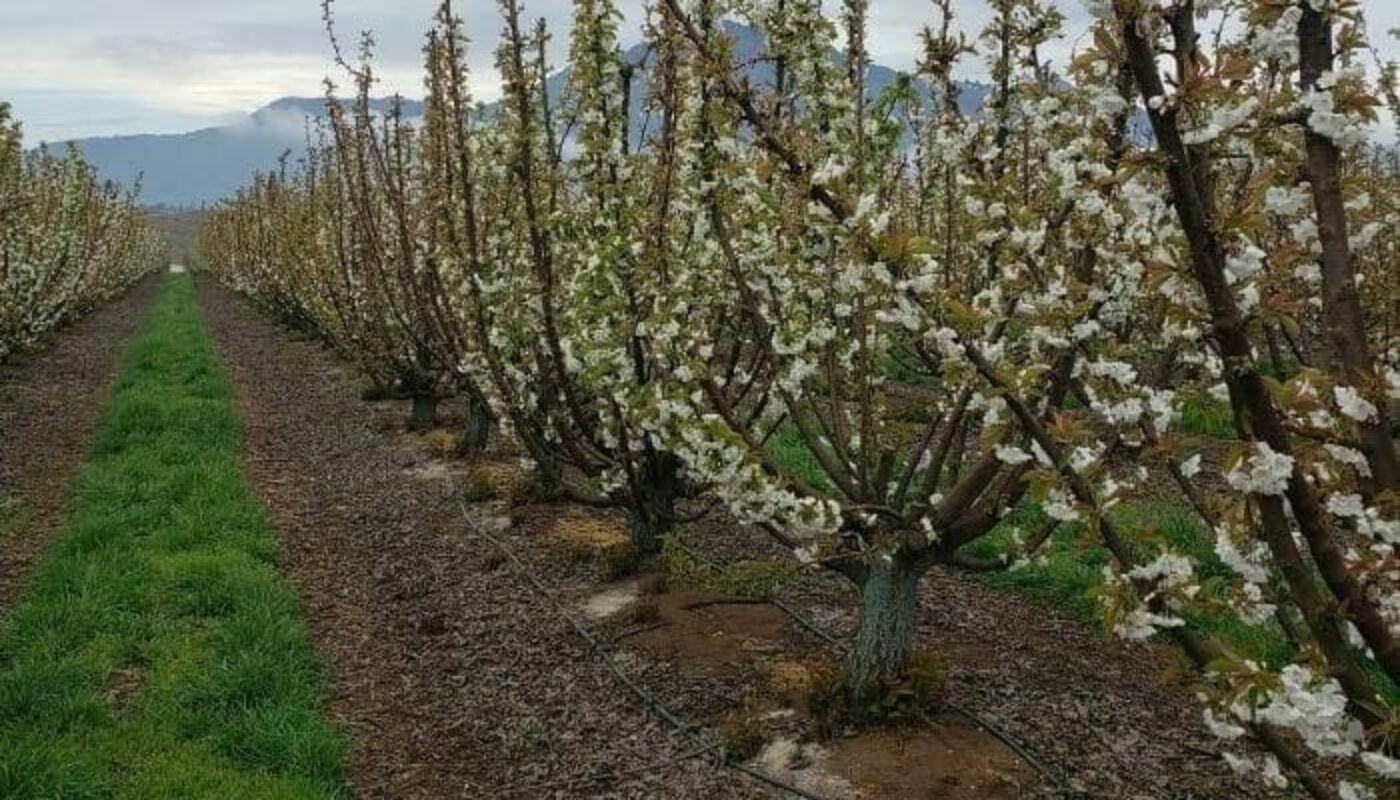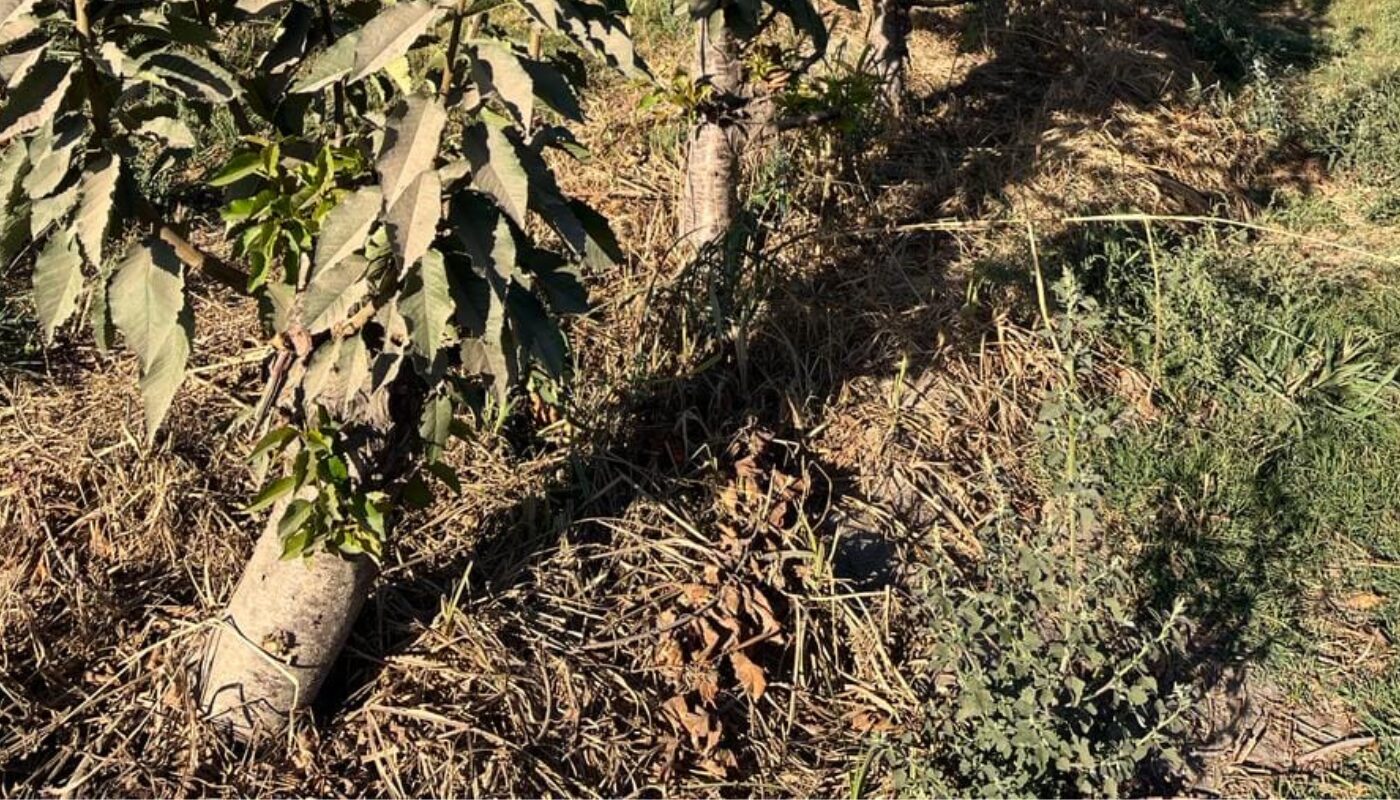The negative effects of weeds on crops include competition for production factors (light, water, nutrients) and/or allelopathy (interaction of organic substances secreted by plants at the root level). The competition that weeds exert on fruit species on production factors will be even more in newly established plantations or young orchards.
An optimal weed control strategy in cherry trees must initially contemplate prevention and eradication, and the subsequent management of weeds, which must consider all cultural practices (manual and mechanical methods), physical, biological and chemical methods, intended to reduce the incidence of them, minimizing the damage that they may cause on agricultural farms.
Chemical control offers effective, timely and often more economical weed control when compared to other methods. Of course, herbicides are excellent tools that must be used appropriately, taking care of the environment and avoiding possible phytotoxicity problems that their misuse could cause.
In industrialized countries, herbicides are applied to 85-100% of all major crops. Finney (1988) predicted that the need for agricultural intensification, as a consequence of the high level of population growth, will increase the use of herbicides. Used cautiously, within an integrated weed management system, herbicides are safe to use for the farmer and pose minimal risk to the environment.
Herbicides can be applied to foliage or soil. Those that are applied to the foliage and affect only the treated part are described as contact herbicides, while those that travel from the treated foliage to a point of action elsewhere on the plant are called systemic herbicides. Soil-applied herbicides that generally affect weed germination have to persist for some time to be effective and are called residual herbicides. Some residual herbicides have contact action and affect the roots and stems as they emerge from the seed, while others enter the root and underground parts of the plant and translocate to their point of action.
Pre-emergence treatments are always carried out before weeds emerge. Post-emergence treatments are generally applied after the crop and weeds have emerged.
Two of the most important factors that determine the effectiveness of the spray are the range or spectrum of droplet size and the coverage of the target by the spray.
The small droplets produce very good coverage and adhere well to surfaces that are difficult to wet, such as the waxy leaves of grasses, but they are exposed to drift and evaporate quickly, especially at low relative humidity. Larger droplets tend to bounce off “hard-to-wet” surfaces, but drift and evaporation are less of a problem in this case. A wide range or spectrum of droplet sizes is best for achieving good coverage of these diverse targets, and proper spray nozzle selection generally meets this requirement.
Herbicide application equipment in fruit growing
There are several pieces of equipment used in fruit growing to develop herbicide applications. Among them we can find: “pumps” or back backpacks, application bars with hydropneumatic equipment (suspended or trailed), application motorcycles with electric bars and pumps, among others.
Herbicide application nozzles
The functions of the nozzle are to divide the liquid into drops, form the spray pattern and control the flow rate of the liquid. The most used nozzles for weed control are fan nozzles. Among the most common are: flat fan nozzles with an application width of 110° or 90° (tips) and “mirror” nozzles that can generate an application width from 130 to 160°.

Within both types of nozzles we have ones with air injection (anti-derivative effect) and without air “injection”. There are various brands on the market and it is recommended to invest in those that guarantee their manufacturing components and their technical qualities, such as the indicated flow rate according to working pressure.
In general and for applications with bars, it is recommended to distance the nozzles between 50 to 60 cm. on the application bar and the recommended application height is 50 to 60 cm.
Spray quality, or droplet size range, becomes finer as the fan nozzle orifice size is reduced, and nozzle angle and application pressure increase. Conversely, spray quality becomes coarser as orifice diameter is increased and nozzle angle and application pressure are reduced.
The quality of the application, like foliar applications, will depend on 3 components:
- Choose a good herbicide product (active ingredient and effective formulation), with sufficient support, a reasonable cost for its objective, ideally with low environmental impact and always consider its dosage range.
- Use agrochemical products at the appropriate time depending on the stages of development of our crop and the weeds to be treated.
- Use application equipment that is always well maintained, clean and optimally calibrated to develop applications in a wide range of water volumes or “application rate”.
Herbicide applications can be carried out at different speeds of advance and will depend on several factors, however, we must always choose the maximum possible speed of traffic in orchards according to the topography and the equipment available for it. The application speed ranges (just as a reference) can be wide from 3.6 (back pumps) to 5.5 km/hour in hydropneumatic equipment suspended with bars and motorcycles with electric pumps with bars.
Do we apply to 100% of the surface or a proportion of it?

We can carry out weed control on the entire surface of a hectare or only on a proportion of it (most frequent recommendation), leaving a central strip of vegetation cover in the center of the rows, which is generally 50% of the surface.
Whatever the choice of weed control management and “vegetable cover” management, herbicide doses are expressed in doses/ha (kg or L).
The volumes of water recommended for applications are diverse and depend on the type of herbicide to be used. As examples, some recommendations are between 100 and up to 300 L/ha.
If we consider an application to 50% of the surface (on a row) and the commercial product recommendation is 2 L/ha with an application volume of 100 L/ha; We must use only 1 L in a “physical” ha and with a volume of 50 L of “wetting”.
The previous example may sound like “common sense”, however, we find inappropriate uses or overdoses of some herbicides because the doses calculated, purchased and applied are the “total” doses per ha.
Following the example and considering an orchard with a planting distance of 4 meters between rows, to apply to 100% of the surface (label recommendation) with a bar with nozzles spaced 50 cm apart; We must have 8 nozzles to cover the width of the rows.
If we consider an application speed of 5.5 km/hour, the time we have to apply “within the crop (without the turns) is 27.27 minutes.
The nozzles that we can choose for this recommendation are: AVI 11001 Orange at 4 bars of pressure (unit flow rate of 0.46 L/minute). Total nozzles: 8.
To cover only 50% of the surface we can achieve it by simply “eliminating” 4 of them (central) and leaving 2 at each end of the herbicide bar.
It will always be advisable to maintain an application height of 50 to 60 cm (maximum) to achieve the width of the wake and a uniform deposit.
Timely and effective weed control will always be part of the result of the profitability of growing cherries and other fruit trees. So pay attention to it!
In order to develop effective and efficient application management plans, we must have equipment previously diagnosed in all its components, repaired and replaced its critical elements, perform annual and periodic maintenance, permanent cleaning and have highly trained personnel to develop the applications that will result in the success of our cultivation to harvest with the least impact on the environment and people.
Originally published on Smartcherry.cl










